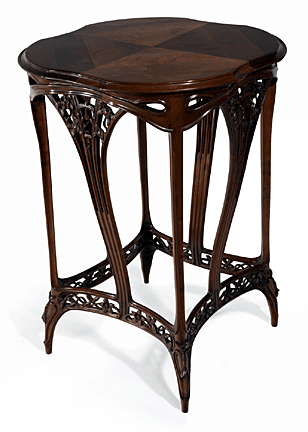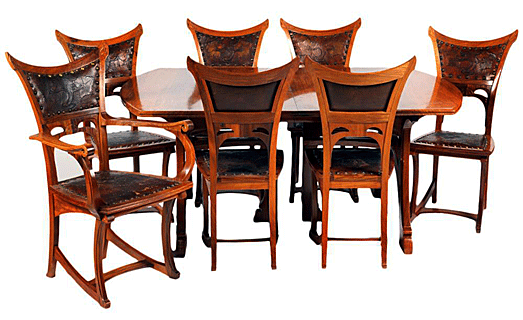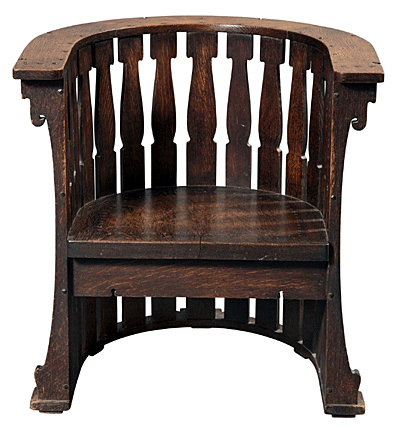|
In
Search of the Controlled Curve
by
Bob Brooke
 Flowers
and insects, leaves and vines, and other natural motifs formed the basis
for a Art Nouveau furniture. But underlying it all was the search for
the controlled curve. Flowers
and insects, leaves and vines, and other natural motifs formed the basis
for a Art Nouveau furniture. But underlying it all was the search for
the controlled curve.
The Relationship of Architecture and
Furniture Design
Furniture in the Art Nouveau style closely resembled the architecture of
the buildings which contained it. In fact, the architects, themselves
often designed it, as well as the floor coverings, light fixtures,
doorknobs, and other decorative details. The furniture was often
complex, featuring fine finishes, usually polished or varnished and
regarded as essential. And furniture from the Continent had curving
shapes that were costly to make. Unfortunately, the owner of an Art
Nouveau home couldn’t change the furniture or add pieces in a different
style without disrupting the entire effect of the room. For this reason,
when Art Nouveau architecture went out of style, so did the furniture.
Organic shapes and curved lines characterized Art Nouveau furniture,
with designs influenced by nature and given shape by excellent
craftsmanship. It usually had no straight lines. Chair backs and table
legs curved gracefully outward, often intersecting with decorative
crosspieces.
 Furniture
designers wished to create a total effect based on a unity of style
which would be distinct from the confusion and eclecticism which had
preceded it. Like Morris and Viollet-le Duc, they felt that art should
be extended to the smallest detail of the environment. Art Nouveau
designers felt it their social duly to introduce art into everyone’s
daily life. Furniture
designers wished to create a total effect based on a unity of style
which would be distinct from the confusion and eclecticism which had
preceded it. Like Morris and Viollet-le Duc, they felt that art should
be extended to the smallest detail of the environment. Art Nouveau
designers felt it their social duly to introduce art into everyone’s
daily life.
Mass production hadn’t yet become so widespread that it caused a
problem. Machinery helped the artisan without influencing the process of
manufacture. Although designers could have their furniture produced in
quantity, they often finished them individually so that no two pieces
looked identical.
Furniture makers designed pieces and accessories with simple, flowing,
fluid lines, taking their cues from the motion and curves of nature.
Fairylike tendrils wove in, out, and around the leaves and stems of
flowers, fruit, and nuts. Foaming ocean waves broke over nude women, and
graceful tree branches swept the earth. The entire effect was one of
delicate sensuality and naturalness, with faint overtones of sentimental
decadence.

And although Art Nouveau furniture designers selected and “modernized”
some of the more abstract elements of the Rococo style, such as flame
and shell textures, they also advocated the use of very stylized organic
forms, expanding the “natural” repertoire to use seaweed, grasses, and
insects.
 But
unlike the craftsmen-oriented of Arts and Crafts, the artists of Art
Nouveau used new materials, machined surfaces, and abstraction in their
designs. The stylized nature of Art Nouveau design made it expensive to
produce, therefore, only the wealthy could afford it. Unlike handmade
Arts and Crafts pieces, the artisans of Art Nouveau produced their
furniture in factories using standard manufacturing techniques. However,
they finished their pieces by hand, giving them a highly polished
appearance. But
unlike the craftsmen-oriented of Arts and Crafts, the artists of Art
Nouveau used new materials, machined surfaces, and abstraction in their
designs. The stylized nature of Art Nouveau design made it expensive to
produce, therefore, only the wealthy could afford it. Unlike handmade
Arts and Crafts pieces, the artisans of Art Nouveau produced their
furniture in factories using standard manufacturing techniques. However,
they finished their pieces by hand, giving them a highly polished
appearance.
The most important architect and furniture designer in the Art Nouveau
style was Hendrik Petrus Berlage, who denounced historical styles and
advocated a purely functional architecture. And like Victor Horta and
Gaudí, he was an admirer of the architectural theories of Eugène
Viollet-le-Duc. He designed his furniture to be strictly functional and
to respect the natural forms of wood, rather than bending or twisting it
as if it were metal. He referred to the features of Egyptian furniture
and preferred chairs with right angles.

The earliest pieces of Art Nouveau furniture, made by Louis Majorelle
and Henry van de Velde, featured the use of exotic and expensive
materials, including mahogany with inlays of precious woods and trim,
and curving forms without right angles. It gave the pieces a sensation
of lightness.

French and Belgian furniture designers embraced the style with more
enthusiasm than those in other countries. Though it by no means entirely
replaced other styles of furniture, which continued to be popular, Art
Nouveau furniture stood in the expensive "art furniture" category.
Belgium
In Belgium, the pioneer architects of the Art Nouveau movement, Victor
Horta and Henry van de Velde, designed furniture for their houses, using
vigorous curving lines and a minimum of decoration. The Belgian designer
Gustave Serrurier-Bovy added more decoration, applying brass strips in
curving forms. In the Netherlands, where the style was called Nieuwe
Kunst or New Art, H. P. Berlag, Lion Cachet and Theodor Nieuwenhuis
followed a different course, that of the English Arts and Crafts
movement, with more geometric rational forms.

The reason the Art Nouveau furniture style took off in Belgium was that
the industrial bourgeoisie was able to afford sumptuous houses and
furniture in the new style.
 Though
Gustave Serrurier-Bovy and Henry van de Velde originally used native
woods such as beech and oak, as did Victor Horta, they also imported
woods from the Belgian Congo, which King Leopold II encouraged. All
three favored fine-grained woods such as citrus and mahogany which
allowed a clean line, as well as fluidity and precision of form. Though
Gustave Serrurier-Bovy and Henry van de Velde originally used native
woods such as beech and oak, as did Victor Horta, they also imported
woods from the Belgian Congo, which King Leopold II encouraged. All
three favored fine-grained woods such as citrus and mahogany which
allowed a clean line, as well as fluidity and precision of form.
The main characteristic of Belgian Art Nouveau furniture was its
architectural quality. , Furniture designers created most of their
pieces to fit in with a particular architectural scheme, so pieces
didn’t look very good out of context. This is particularly true of both
Horta and Van de Velde, and to certain degree to pieces made by
Serrurier-Bovy.. Serrurier and Horta sought to achieve unity between
architecture and furniture, and Van de Velde, a self-taught man,
concentrated on the home and its decor at the same time each of these
designers showed expressed their individualism. Horta believed the curve
of the furniture represented not so much the flower but the stem while
Van de Velde believed in the smooth sensuousness of waves.
 English
furniture design first influenced Serrurier-Bovy. He visited London and
imported Liberty furniture and accessories for his shop in Liege. His
encounter with the Paris Exhibition Universelle of 1900, where he
decorated one of the restaurants, the Pavilion Bleu, modified his style
and signaled a new feeling for movement and the controlled curve. He was
perhaps the first to break away from the era of workshop technology. He
designed a suite of completely collapsible “Sliex” furniture in
birchwood. Serrurier-Bovy never used artificial aids or paint, and kept
all decorative fantasy and ornament for the walls or windowpanes. A true
follower of Viollet-le-Duc, he maintained rigorous standards of logic
and solidity in every piece that left his workshops. English
furniture design first influenced Serrurier-Bovy. He visited London and
imported Liberty furniture and accessories for his shop in Liege. His
encounter with the Paris Exhibition Universelle of 1900, where he
decorated one of the restaurants, the Pavilion Bleu, modified his style
and signaled a new feeling for movement and the controlled curve. He was
perhaps the first to break away from the era of workshop technology. He
designed a suite of completely collapsible “Sliex” furniture in
birchwood. Serrurier-Bovy never used artificial aids or paint, and kept
all decorative fantasy and ornament for the walls or windowpanes. A true
follower of Viollet-le-Duc, he maintained rigorous standards of logic
and solidity in every piece that left his workshops.
 Horta
based his furniture designs on the same principles as his architecture.
He held that the form of the building should determine the form of the
furniture. He believed each part should fit properly and logically into
the whole. Before handing over his design to craftsmen to be made, he
crafted a plaster model in precise detail. He emphasized the rhythm of
curve and counter-curve which was typical of his work and which often
occurred in the rounded angles of his furniture by the restrained and
subtle use of molding. Also, he designed the tones of the woods he used
as features in the general style of the house, so there was a harmony of
mass and color in the door frames. panelling and painted decoration. He
was the uncompromising creator of a homogeneous and forceful style. Horta
based his furniture designs on the same principles as his architecture.
He held that the form of the building should determine the form of the
furniture. He believed each part should fit properly and logically into
the whole. Before handing over his design to craftsmen to be made, he
crafted a plaster model in precise detail. He emphasized the rhythm of
curve and counter-curve which was typical of his work and which often
occurred in the rounded angles of his furniture by the restrained and
subtle use of molding. Also, he designed the tones of the woods he used
as features in the general style of the house, so there was a harmony of
mass and color in the door frames. panelling and painted decoration. He
was the uncompromising creator of a homogeneous and forceful style.
 Van
de Verde, on the other hand, approached the problem of furniture design
in an experimental way. He was the most linear of designers. For him,
the curve as an element of design was “dynamographique et structural.”
He used it first as a series of parallels, and then to encircle larger
areas which he edged with subtle carvings. Van de Verde thought deeply
both about the form and construction of furniture and also about its
emotive effects. And at all times, he remained influenced by the
two-dimensional work he had done as a painter. Van
de Verde, on the other hand, approached the problem of furniture design
in an experimental way. He was the most linear of designers. For him,
the curve as an element of design was “dynamographique et structural.”
He used it first as a series of parallels, and then to encircle larger
areas which he edged with subtle carvings. Van de Verde thought deeply
both about the form and construction of furniture and also about its
emotive effects. And at all times, he remained influenced by the
two-dimensional work he had done as a painter.
France
 Nancy
was the center of Art Nouveau furniture design in France. Two designers,
Émile Gallé and Louis Majorelle had their studios and workshops there,
along with the Alliance des industries d'art—later called L’Ecole de
Nancy, founded in 1901. Both designers based their structure and
ornamentation on forms taken from nature, including flowers and insects,
such as the dragonfly, a popular motif in Art Nouveau design. Gallé
became especially noted for his use of marquetry in relief, in the form
of landscapes or poetic themes. Majorelle Nancy
was the center of Art Nouveau furniture design in France. Two designers,
Émile Gallé and Louis Majorelle had their studios and workshops there,
along with the Alliance des industries d'art—later called L’Ecole de
Nancy, founded in 1901. Both designers based their structure and
ornamentation on forms taken from nature, including flowers and insects,
such as the dragonfly, a popular motif in Art Nouveau design. Gallé
became especially noted for his use of marquetry in relief, in the form
of landscapes or poetic themes. Majorelle
 became
known for his use of exotic and expensive woods, and for attaching
bronze sculpted in vegetal themes to his pieces of furniture. became
known for his use of exotic and expensive woods, and for attaching
bronze sculpted in vegetal themes to his pieces of furniture.
Both designers used machines for the first phases of manufacture but
finished all of them by hand. Other notable furniture designers of the
L’Ecole de Nancy included Eugène Vallin and Émile André; both were
architects by training, and both designed furniture that resembled the
furniture from Belgian designers such as Horta and Van de Velde, which
had less decoration and followed more closely the lines of curving
plants and flowers.
Germany and Austria
 Continental
designs were much more elaborate, often using curved shapes both in the
basic shapes of the piece, and in applied decorative motifs. In Germany,
the furniture of Peter Behrens and the Jugendstil featured straight
lines and some decoration attached to the surface. Their goal was
exactly the opposite of French Art Nouveau—simplicity of structure and
materials for furniture that could be inexpensive and easily
mass-produced. The same was true for the furniture of designers of the
Wiener Werkstätte in Vienna, led by Otto Wagner, Josef Hoffmann, Josef
Maria Olbrich and Koloman Moser. The furniture was geometric and had a
minimum of decoration, though in style it often followed the Biedemeier
style. Continental
designs were much more elaborate, often using curved shapes both in the
basic shapes of the piece, and in applied decorative motifs. In Germany,
the furniture of Peter Behrens and the Jugendstil featured straight
lines and some decoration attached to the surface. Their goal was
exactly the opposite of French Art Nouveau—simplicity of structure and
materials for furniture that could be inexpensive and easily
mass-produced. The same was true for the furniture of designers of the
Wiener Werkstätte in Vienna, led by Otto Wagner, Josef Hoffmann, Josef
Maria Olbrich and Koloman Moser. The furniture was geometric and had a
minimum of decoration, though in style it often followed the Biedemeier
style.
Scotland
 For
Art Nouveau architecture and furniture design, the most important center
in United Kingdom was Glasgow, with the creations of Charles Rennie
Mackintosh and the Glasgow School, whose work was inspired by Scottish
baronial architecture and Japanese design. Mackintosh gained a major
reputation as a furniture designer and decorator, working closely with
his wife, Margaret Macdonald Mackintosh, herself a prominent painter and
designer. Together they created striking designs that combined geometric
straight lines with gently curving floral decoration, particularly a For
Art Nouveau architecture and furniture design, the most important center
in United Kingdom was Glasgow, with the creations of Charles Rennie
Mackintosh and the Glasgow School, whose work was inspired by Scottish
baronial architecture and Japanese design. Mackintosh gained a major
reputation as a furniture designer and decorator, working closely with
his wife, Margaret Macdonald Mackintosh, herself a prominent painter and
designer. Together they created striking designs that combined geometric
straight lines with gently curving floral decoration, particularly a famous symbol of the style, the Glasgow Rose."
famous symbol of the style, the Glasgow Rose."
The United States
Unfortunately, furniture designers in the U.S. looked more to historic
American furniture design and that of the Arts and Crafts Movement
rather than Art Nouveau. Charles Rohlfs of Buffalo, New York, however,
was one designer who embraced Art Nouveau through his use of Celtic and
Gothic art motifs in his pieces made of white oak.
<
Back to Antiques Archives
Next Article > |
